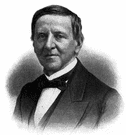|
|

The Election of 1876
An election decided not by the popular vote but by the Electoral College was that of 1876. By then, the concept of a popular vote was well established and the electoral vote had become a reflection of that popular vote. In 1876, however, that wasn't the case.
The United States in 1876 was still healing from the wounds of the Civil War. Federal troops were still in Southern states, sometimes in large numbers, enforcing the Thirteenth, Fourteenth, and Fifteenth Amendments. Reconstruction was still going on in a big way, and many people in the South resented what they saw as the continuation of an occupation by the victorious North.
The two presidential terms of Ulysses S. Grant were marred by political scandal as well, and a constant them during the election campaigns was political honesty and restoring trust in government.
By this time, also, the presence of many candidates for president in the general election was limited if not nonexistent. In this election, only two major candidates appeared. (As a historical footnote, 85-year-old Peter Cooper was the nominee of the National Greenback Party; he received no electoral votes.)
The Democratic Party, the party of Andrew Jackson, had nominated as its nominee Samuel J. Tilden, the governor of New York. The Republican Party, meanwhile, relatively new to the political scene, had nominated the governor of Ohio, Rutherford B. Hayes.
 When the popular votes were counted, Tilden had the most, more than 280,000 more than Hayes. But he didn't have enough electoral votes to win. At that time, the total number of electoral votes was 369. Tilden had 184, one fewer than what he needed to win. Being one vote short was the same as being 100 votes short, however, because he still wasn't elected. Hayes, meanwhile, had 165. All he needed was 20 votes. And, conveniently for him, 20 electoral votes were in dispute.
When the popular votes were counted, Tilden had the most, more than 280,000 more than Hayes. But he didn't have enough electoral votes to win. At that time, the total number of electoral votes was 369. Tilden had 184, one fewer than what he needed to win. Being one vote short was the same as being 100 votes short, however, because he still wasn't elected. Hayes, meanwhile, had 165. All he needed was 20 votes. And, conveniently for him, 20 electoral votes were in dispute.
Florida, Louisiana, and South Carolina still had Reconstruction governments. Oregon had one elector who was a postmaster. This was just the beginning of strange goings-on.
The postmaster of Oregon, a Republican, was forbidden from voting because he worked for the federal government. His replacement was appointed by the governor of Oregon, who was a Democrat and who, naturally, appointed a Democrat in place of the Republican postmaster.
Florida, Louisiana, and South Carolina were a bit more complex in that leaders of both the Democratic Party and the Republican Party reported vote totals. Not unexpectedly, the Democratic Party vote totals for these three states showed Tilden the winner and the Republican Party vote totals for those same three states showed Hayes the winner.
What to do? The Constitution was silent on the matter. In desperation, Congress appointed a special commission to decide the election.
The Electoral Commission had 15 members: 5 Representatives, 5 Senators, and 5 Supreme Court justices. Of these 15 members, 8 were Republican and 7 were Democrat. By a vote of 8-7, they decided to award all of the disputed votes to Hayes, giving him 185 electoral votes, exactly the number he needed to become president.
 It was not over, though. Congress still had to approve the commission's findings. Behind-the-scenes maneuvering resulted in approval of the 8-7 vote giving Hayes the presidency, in exchange for removing Federal troops from the South, a plan to spur industrialization in Southern states, and to make sure that a Democrat had a prominent part in the new (Republican) president's Cabinet.
It was not over, though. Congress still had to approve the commission's findings. Behind-the-scenes maneuvering resulted in approval of the 8-7 vote giving Hayes the presidency, in exchange for removing Federal troops from the South, a plan to spur industrialization in Southern states, and to make sure that a Democrat had a prominent part in the new (Republican) president's Cabinet.
This long certification process went on for months, finally confirming Hayes as president just two days before Inauguration Day (which in those days was March 4).
One of Hayes's first actions as president was to remove all remaining Federal troops from Southern states, leaving those states to work out Reconstruction issues on their own.
|
|